Hyperliquid has allied with market makers to provide initial liquidity for HyperCore, but all of this is built on the expectation of $HYPE, meaning that market makers will receive a longer-term profit share.
As mentioned earlier, the gradual expansion of HyperBFT nodes is achieved through asset swapping, where the foundation's token shares are transferred to market maker nodes in exchange for their long-term liquidity commitment.
Thus, $HYPE becomes a liability for Hyperliquid, needing to meet the demands of market makers, HLP, and token holders simultaneously. It is important to note that the demands of the three parties are not entirely consistent. If the price of $HYPE does not rise over the long term, retail holders will inevitably sell, harming the interests of market makers. However, if the price rises too quickly, it could trigger massive sell-offs by whales or even lead to economic collapse.
A reasonable price for $HYPE should be 10% of $BNB, which is $100. However, the average price of $50 in a volatile market leaves enough room for appreciation and a lower starting point for declines during a bear market, alleviating pressure.
Before Selling Security
Directly selling liquidity is the price of MM, and it must be packaged as a dragon-slaying youth.
Any product/business/model in the crypto space must address two core issues:
- What to sell as an asset
- How to sell it
Before the launch of HyperEVM, facing accusations of excessive market centralization, the Hyperliquid team began to expand HyperBFT nodes, gradually introducing external participants. In early February, they launched HyperUnit to facilitate external capital entering HyperCore, laying the groundwork for external public chains and HyperEVM.
Just like the launch of Builder Codes in October 2024, leading up to the integration of Phantom in July 2025 to ignite market traffic.
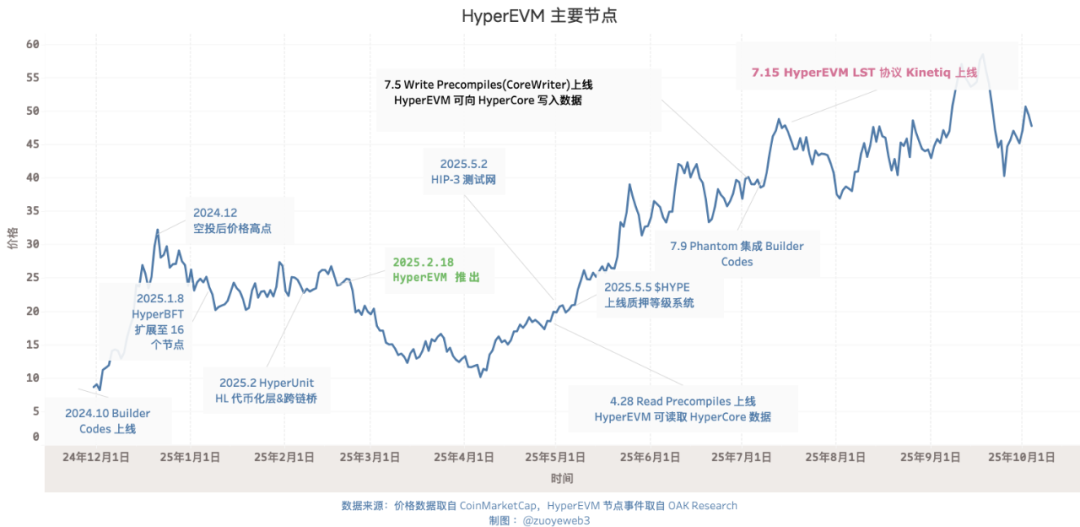
Image Caption: Main Nodes of HyperEVM
Image Source: @zuoyeweb3
In February 2025, HyperEVM went live, followed by the gradual formation of read/write precompiled contracts for HyperCore and HyperEVM from April to July, after which ecological projects began to launch progressively.
What truly inspires us is that after the distribution of 31% of the token shares through airdrops, a significant selling pressure for Hyperliquid's asset swap was created. HyperCore went live three months after the airdrop in March; it would be unreasonable to say there was no prior research. A more reasonable explanation is that they chose a timing to act:
- At this point, $HYPE nodes were slightly more dispersed to meet public expectations;
- The price hovered below $25, making it relatively acceptable for all participating nodes;
- The pressure on the Hyperliquid team to "pump" was relatively low.
With nodes dispersed and asset swapping initiated, security was sold to nodes as an asset. Before migrating HyperCore's security to HyperEVM, $HYPE completed its first phase of large transactions.
Projects are created on-chain, and assets are issued on exchanges.
The crypto network effect can be roughly equated to public chains and CEXs, with stablecoins being the only outlier that bridges crypto to the traditional world and its people.
Looking at the timeline of crypto after the FTX collapse, the focus of ETH L2 is not ZK, but high-performance L2s like MegeETH that have "Solana"-like characteristics. Monad/Berachain/Sonic (Fantom) all stimulate liquidity around their mainnet tokens, with liquidity having no long-term preference for them.
In the competition among exchanges, how to face Binance is the main task for offshore exchanges like OKX/Bybit/Bitget, compliant exchanges like Coinbase/Kraken, and the emerging Robinhood. They all coincidentally choose to "trade everything." Robinhood opts for L2, prediction markets, and altcoins like $CRV, while Kraken moves towards wallets, L2, USDG, and listings. Bybit supports Mantle, OKX redesigns XLayer, and the amusing Bitget UEX (panoramic exchange) emerges.
Whether for exchanges or public chains, the goal is to connect liquidity and token circulation. Before issuing tokens, one-way stimulation of liquidity is relatively simple. After issuing tokens, the two-way cycle of liquidity empowering tokens and tokens feeding back into liquidity mostly fails to establish, as seen from Berachain to the crypto king AC's Sonic.
The entire history of cryptocurrency is a history of asset creation. Since Bitcoin, public chains have become the birthplace of asset creation and issuance networks. However, the high entry costs have made completely decentralized platforms like CEX powerful intermediaries for attracting newcomers and listing new coins, even leading to the development of exchange public chains as dependent products.
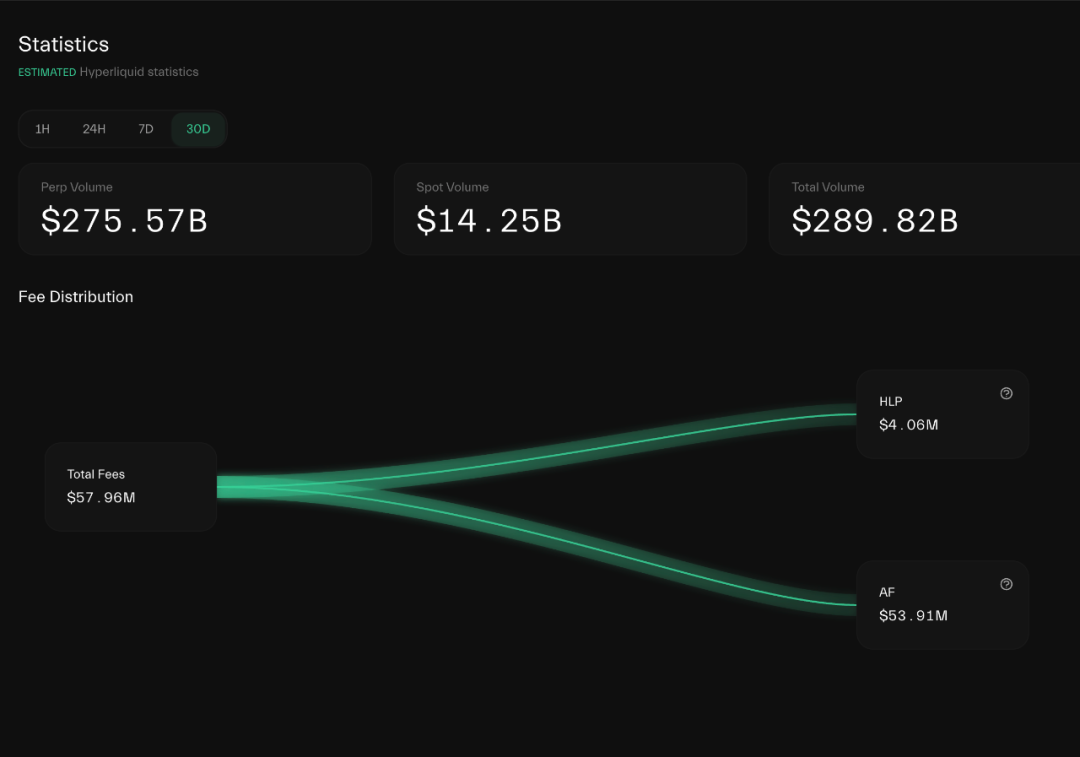
Image Caption: Hyperliquid Fee Flow
Image Source: @hypurrdash
If we only observe the market performance of $HYPE, it is difficult to distinguish it from projects stimulated by tokens, as over 92% of the revenue is used for straightforward buybacks.
Hyperliquid's liquidity is also stimulated, but through a relatively smooth asset swapping model, along with the team's self-restraint and the absence of a centralized unlocking and selling mechanism from traditional VCs, the liquidity of HyperCore and the relative stability of the $HYPE price have been maintained.
Therefore, after replicating the liquidity of CEX, HyperCore must move towards an open public chain architecture, making $HYPE more like ETH, becoming a "currency" with real consumption scenarios. Currently, it is far from achieving this.
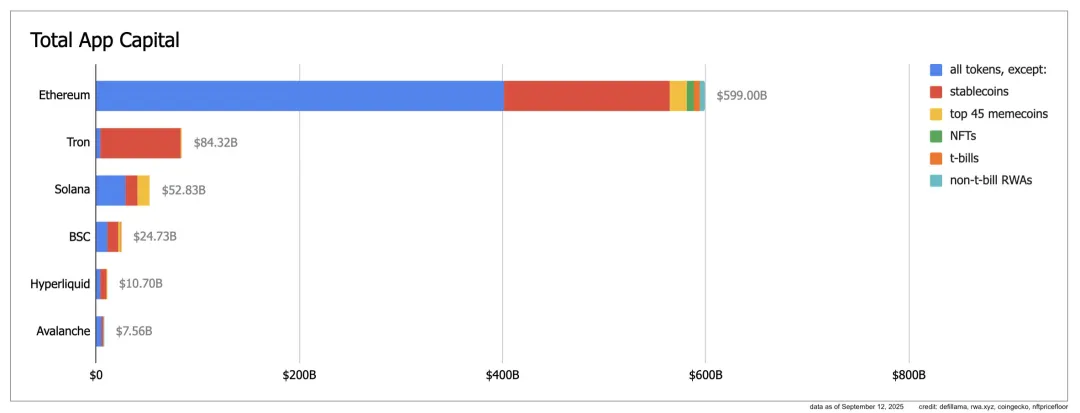

Image Source: @ryanberckmans
According to App Capital metrics, Ethereum relies on the circulation scale of altcoins and stablecoins reaching $600 billion, Tron stands out solely due to stablecoins, and Solana has a relatively healthy structure, with stablecoins, altcoins, and memes sharing the market, but on a smaller scale. Hyperliquid mainly consists of stablecoins and altcoins, reaching a scale of $10 billion.
Note
App Capital measures the real capital flow scale of public chains, not accounting for the value of the mainnet's own tokens, and only calculating the circulation value of tokens on it, rather than FDV or TVL.
Alternatively, it can be said that the assets on Hyperliquid, apart from BTC/ETH/SOL bridged from Unit, mainly derive their value from $HYPE. This does not conflict with the exclusion of mainnet tokens from the calculation, as $kHYPE wrapped by LSTs like Kinetiq is also a "DeFi" token, and Morpho/HyperLend primarily entered the HyperEVM ecosystem based on the stimulation of $HYPE.
We mainly explain the latter. On the surface, HyperEVM does not rely on buybacks or subsidies to develop its ecosystem, but in reality, ecological projects exhibit two characteristics:
- LSTs, lending, and yield primarily develop around $HYPE-derived assets;
- Neutral tools like DEXs cannot gain traction, with HyperSwap's TVL being very low.
Taking Kinetiq as an example, it is more like an on-chain reissuer of $HYPE, starting from Lido's version of LST and gradually entering various product lines like lending, stablecoins, and yield, with its TVL around $25 million. Kinetiq itself is also one of the HyperBFT nodes.
In contrast, the main AMM DEX on HyperEVM, HyperSwap, has a TVL of only about $44 million. While there are conflicts with HyperCore's positioning, it still pales in comparison to Pancakeswap's $2.5 billion TVL and Uniswap's $5.5 billion TVL.
This also validates the importance of App Capital. The assets on HyperEVM are still a reissuance channel for $HYPE, and there is still a long way to go before becoming an independent ecosystem.
After Selling Liquidity
Choice is an illusion created between those with power and those without.
Although Hyperliquid strives to create a value closed loop for HyperEVM, as of now, it still revolves around the liquidity of $HYPE and HyperCore, and the value of HyperEVM itself has not been synergized with it.
This conflicts with our daily conceptual framework. In any materials we see, the great significance of HIP-3, Core Writer, and Builder Codes is often mentioned, as if these three allow the liquidity of HyperCore to seamlessly migrate to HyperEVM.
But this is an "illusion." HyperCore, through the aforementioned technological innovations, sells a "liquidity" deployment right, which does not equate to providing trading liquidity for the project.
To put it more bluntly, Hyperliquid is selling the technical architecture of HyperCore, much like Aave's friendly fork.
Tip
Aave DAO designs a friendly fork model, allowing third parties to directly use Aave's code for development, but requiring them to share a portion of the protocol's revenue with Aave. HyperLend is one such example.
From Read Precomplies to Write Precomplies (i.e., CoreWriter System), the ability to directly read and write HyperCore data on HyperEVM is established. This is actually a common model for connecting the two, which is to open access to HyperCore.
Access rights ≠ liquidity initialization. Any HyperEVM project that wants to use HyperCore liquidity must seek funding to generate liquidity on its own.
Hyperliquid will not provide subsidies, which requires project teams to showcase their abilities. HyperBeat seeks external financing, while Hyperlend insists on community leadership.
This creates an unequal relationship: Hyperliquid will not provide $HYPE incentives for HyperEVM projects but will induce them to build around $HYPE to promote the real use of the token.
From Invite Code to Builder Codes
In fact, this has already been revealed in Builder Codes. Previously, CEX rebate programs highlighted the use of invite codes to differentiate sources, testing the "pyramid scheme" and conversion abilities of promoters and community leaders, which is why CEXs would invest heavily in various KOLs.
However, Hyperliquid adopts a Taobao rebate model, not minding if you change your appearance, encouraging developers and project teams to start businesses around HyperCore liquidity, building their own brands and front ends, with HyperCore willingly taking on the role of liquidity provider.
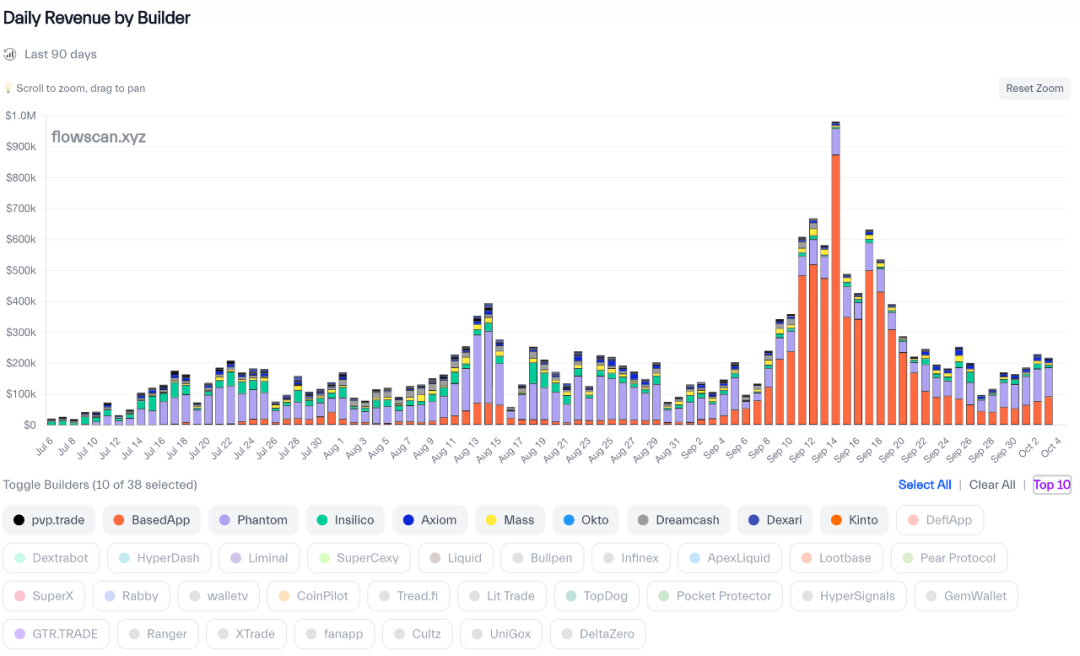
Image Caption: Builder Codes Revenue Ranking
Image Source: @hydromancerxyz
After providing a unified liquidity backend, BasedApp can create its own Robinhood experience, and Phantom can embed its contracts into its ecosystem, allowing for any customization and profit-sharing.
From Fixed Contracts to Custom Contracts
Following the model of Builder Codes, Hyperliquid launched the HIP-3 proposal, allowing users to create any contract market on HyperCore, including prediction markets, forex, or options.
From a product perspective, this is a contract auction mechanism following the spot auction, still operating on a 31-hour cycle, merely requiring a $HYPE margin of 500,000 tokens (approximately $25 million).
However, with the addition of the Core Writer protocol, HIP-3 effectively opens up a circular leverage between HyperEVM and HyperCore. HIP-3 was originally proposed by the LST protocol Kinetiq, which also operates a HyperBFT node.
Through the CoreWriter and HIP-3 protocols, Kinetiq guides $HYPE from DeFi protocols on HyperEVM back to HyperCore, triggering a de facto deflation.
Furthermore, Kinetiq also provides crowdfunding auction services, allowing everyone to pool funds to create rights. One can imagine that the $HYPE staked on HyperCore ultimately becomes the contract margin for HyperCore.
- Users pool funds or project teams provide 500,000 $HYPE to participate in the auction;
- After the project starts, it is deployed on HyperCore, with initial trading liquidity resolved independently;
- The fees generated by the project are denominated in $HYPE, with 50% profit-sharing to Hyperliquid;
- In case of project misconduct, Hyperliquid will proportionally confiscate the staked $HYPE.
From a more understandable perspective, the trading volume on HyperCore is the valuation basis for $HYPE, while HyperEVM amplifies the valuation of $HYPE, allowing the ecosystem to compete for price benchmarks and increase real usage, freeing itself from excessive reliance on buybacks.
Under the dual-structure system, the controllable HyperCore requires the free HyperEVM. Only by completing the open permissions can the value of $HYPE spiral upward.
Under HyperCore's buyback mechanism, Hyperliquid's growth story can only be to become a complete Binance, while HyperEVM allows $HYPE itself to have the option to trigger secondary liquidity.
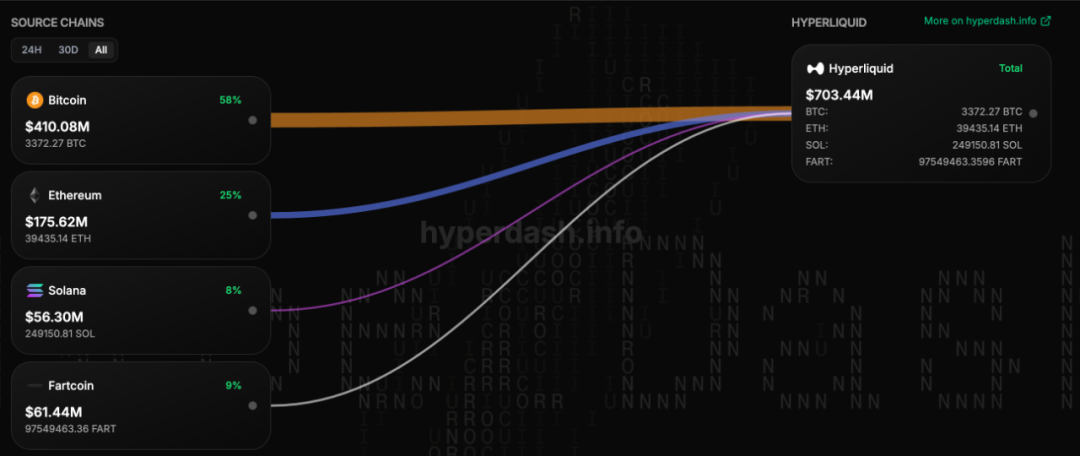
Image Caption: Unit Bridged Asset Classification
Image Source: @hypurrdash
This is similar to the purpose of introducing BTC/ETH through Unit, which is to promote the growth of $HYPE as trading fees. Let’s not forget that $FTT, as FTX's main asset reserve, ended in collapse.
HIP3 and the CoreWriter system fundamentally change Hyperliquid's valuation and positioning, with $HYPE set to strike with a complete public chain + exchange status.
Conclusion: From S1 to S3
I don’t wear my heart upon my sleeve.
This article focuses on how Hyperliquid organizes the initial liquidity of HyperEVM, with less attention paid to the current state of the HyperEVM ecosystem.
Now, HyperEVM can essentially be viewed as a wrapper and amplifier for $HYPE, with no project or mechanism truly independent of $HYPE yet, mostly being migrations or imitations of ETH projects.
Suddenly, Hyperliquid issued NFTs for Season 2 users. Considering that Season 1 examined Perp trading volume, Season 2 will assess spot + Perp trading volume, and S3 will likely evaluate HyperEVM trading volume.
When facing competitors like Aster, Hyperliquid "reissues" S2 NFTs, which can promote HyperEVM trading volume and set a good stage for S3, creating a seamless connection—truly remarkable.
First, create a controllable HyperCore, then an open HyperEVM. You might think the linker is the CoreWriter system, but in reality, it is the dual role of $HYPE.
免责声明:本文章仅代表作者个人观点,不代表本平台的立场和观点。本文章仅供信息分享,不构成对任何人的任何投资建议。用户与作者之间的任何争议,与本平台无关。如网页中刊载的文章或图片涉及侵权,请提供相关的权利证明和身份证明发送邮件到support@aicoin.com,本平台相关工作人员将会进行核查。




